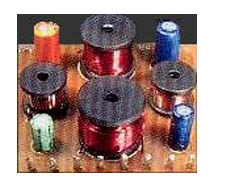
At the crossover frequency, XL and XC, must = root 2 (1.414) of the loudspeaker Impedance.
L Inductors may have approx 150 – 300 turns of 1 mm wire.
The resistance of the wire can be between 0.5R – 1R. This can be included in the calculations.
Capacitors may be between 4.7μF – 47μF.
Capacitors should be non-polarized and ≥ 100-volt rating.
Loudspeaker Impedance should be measured at the crossover frequency. The specified Impedance will be accurate for the majority of dome tweeters, bullet tweeters and compression drivers. Most cone speakers will be accurate between 200 Hz – 600 Hz.
An 8R loudspeaker will be 8R, a 4R loudspeaker will be 4R. But from 600 Hz and above (upper voice), most cone loudspeakers will have a higher Impedance than specified.
—R or Ω, measured in ohms, is constant Resistance over frequency
—XC Capacitive Reactance, measured in micro-Farads (μF), is variable Impedance over frequency. (amperes leads volts 90deg)
—XL Inductive Reactance, measured in milli-Henry (mH), is variable Impedance over frequency. (volts leads amperes 90deg)
—Z Impedance, measured in ohms, is variable Resistance over frequency with any combinations of (R – XL – XC)
Some designers go into extraordinary detail to adjust for the rising Impedance of the mid loudspeaker. Adjustment for this rising impedance does make the crossover technically accurate. This correction has little effect on musical performance and no effect on reliability of loudspeaker or amplifier. Often, only the designer can hear the difference and if you are the designer you can choose to do it.
The Exceptions: 18 dB/octave passive crossovers are essential in professional systems for stopping low frequencies getting into compression drivers. These drivers are expensive and can easily be destroyed with a few watts of power at low frequency. Many of these systems are small, portable 2-way passive loudspeaker boxes (12-in or 15-in and horn).
Passive Crossover Danger: The Reactance (X) of L and C, shift phase between volts and amperes, therefore reducing power (watts). L and C are in series and phase is shifted in opposite directions between them.
This is called a “series resonant” circuit. If the loudspeaker is not connected to the crossover or the loudspeaker has blown up the LC “series resonance” becomes a short circuit at the crossover point. The amplifier can easily be destroyed.
There are many excellent books, web sites and software programs that give precise construction detail and formulas for passive crossover design. But they require good math and basic electronic knowledge.

